Sichuan Tourism: From Huanglongxi Ancient Town in Chengdu to Kuanzhai Alley (Photo)
The last day of the Chuanzhidian itinerary is still a one-day trip to Chengdu for free activities. After a simple strategy on Ctrip travel, the reporter decided to use this day to make a one-day trip from Huanglongxi Ancient Town to Kuanzhai Alley.

Chengdu Metro Line 5 (Photo: Feng Ganyong)
2021.09.22 At 8 a.m., the reporter and his party set off from the Jincheng Hotel in Chengdu where they stayed. Turn right not far from the door and is Fuqin Subway Station. According to the route guided by Baidu map, first take Metro Line 5 for about 50 minutes to the terminal point of Huilong Station, and then go to the ground. Transfer to the S18K special line and reach the terminal station Huanglongxi in about 30 minutes. Get off the bus and walk for nearly ten minutes, and arrive at Huanglongxi Ancient Town Scenic Area at 09:40.

Photo taken in front of the archway in Huanglongxi Ancient Town
Not far after passing the archway of the first Huanglongxi ancient town, you will arrive at the entrance of the ancient town scenic spot. Entering the gate is a sightseeing road called Western Sichuan Folk Street that leads deep into the scenic area. So I stopped by the way and entered the ancient town and started wandering.

Western Sichuan Folk Street (Photo: Feng Ganyong)
Huanglongxi Ancient Town, located in Shuangliu County, about 30 kilometers southeast of Chengdu City, is an ancient historical and cultural town and provincial tourist scenic spot in Sichuan Province. The ancient town not only has beautiful scenery and beautiful environment, but also a well-known natural film and television photography base at home and abroad. The main features of the ancient town are: ancient streets, ancient trees, ancient temples, ancient water and land docks, ancient buildings and simple folk customs. It is named by the Ministry of Culture as the hometown of Chinese folk art (Fire Dragon) and a national-level small town with beautiful environment. It is known as the "Film and Television City" and "Chinese Hollywood". It is one of the top ten ancient towns in water towns.

Tour map of Huanglongxi Ancient Town (Photo: Feng Ganyong)
Looking back at historical data,"Chishui and brocade converge, the stream is brown, and the river water is clear." The ancients called it: "Huanglong crosses the Qingjiang River, and the real dragon is hidden in the middle.""Li Du" records the "Huanglong Ganlu Monument":"Huanglong Seeing Wuyang, we built a tripod, shaped like a dragon and submerged in the water... Therefore, it is called "Huanglong River". In the 24th year of Jian 'an (216 AD), during the Han Dynasty, Wuyang and Pengshan in Xinjin were bordered to the southeast of Dongxian (Hua County). Renshou was also like Longya. The place where Huanglong was in spring belonged to Wuyang and governed by the public. Therefore, the river was named "Huanglong River."

Ancient Town Corridor (Photo: Feng Ganyong)
Historically, Huanglongxi Town has always been an important military town south of Chengdu. It is said that during the Shu Han Dynasty, Zhuge Liang marched south and sent heavy troops to guard this place. Huanglong River, formerly known as Yongxing Farm, was originally located in Lixin Village on the east bank of the Fuhe River. It was destroyed in a fire, so it was also known as the "Huoshao Farm" and was later moved to both sides of the Fuhe River to build a farm.

Photo taken by Zhuge Ting (Photo: Wang Jue)
More than 2100 years ago, the ancestors of ancient Shu thrived here; the ancient tombs of the Han Dynasty left the footprints of their predecessors; the Shu and Han regime sprouted here; Zhuge Liang stationed troops and grazing horses during the southern expedition; during the Tang and Song Dynasties, the Golden Waterway became increasingly prosperous. It became a distribution center for the Silk Road in the South; many historical stories are circulated in wooden houses and bluestone paths in the Ming and Qing Dynasties.

Photo taken in front of the archway of the No. 1 Town in Sichuan Prefecture
The Gulong Temple, Zhenjiang Temple and Chaoyin Temple scattered in the south, north and middle of the old street of the ancient town form a unique landscape with temples in the street and streets in the temple; the all-wooden ancient stage with a history of more than 300 years is well preserved; Six thousand-year-old ancient banyan trees conceal the phantom of the ancient town; the ancient Tangjia Courtyard interprets the Hakka culture; the yamen of the three counties tell the history of the Republic of China; the Chen family water mills make visitors feel nostalgic about the past; the simple folk customs add to the endless charm of the town.

Photo taken by ancient town sculptures (Photo: Wang Jue)
The battle for military forces and the gathering of merchants gave birth to a rich dock culture; the unique style of the pastoral ancient town in western Sichuan has become the number one natural film and television base in Southwest China. The ancient town is famous both at home and abroad, and tourists come here; they pay tribute to ancient relics, enjoy old streets, search for humanities, and express their love for mountains and rivers.

Xizhaimen, Ancient Town (Photo: Feng Ganyong)
On the way, you will come to a square with a giant tripod in the center of a fountain in the scenic area. From here, you will really come to the entrance of Huanglongxi Ancient Town and enter Xizhaimen of the ancient town. Suddenly, a scene with a Jiangnan flavor will hit people's eyes. The stream gushing out from the dragon head forms a long waterway from top to bottom that stretches deep into the ancient town of Huanglongxi. There are rows of shops on both sides of the waterway, making it extremely lively.

Fountain Square (Photo: Feng Ganyong)
People can see here that the ancient cultural tourist attractions of Huanglong River are as numerous as bright pearls. From the scenic area, it can be divided into three ancient scenic areas connected by water, namely the core scenic area, the spread scenic area and the extended scenic area.

The streets and alleys of the old streets of the ancient town (Photo: Feng Ganyong)
There are also countless specialty snacks in the ancient town of Huanglongxi, and you can't eat them. Internet celebrity Yigen noodles, also known as "longevity noodles", are a famous traditional snack in Huanglongxi Ancient Town during the Song, Yuan, Ming and Qing Dynasties. At noon, the reporter's lunch was a simple and affordable noodle and Sichuan jelly.

Walking into the ancient town of Huanglongxi (Photo: Feng Ganyong)
Speaking of the fact that Huanglongxi Ancient Town has been used as a film and television shooting site since the 1980s, and it is really an established photography base. In 1983, when the ancient town of Huanglongxi was still hidden in the boudoir and no one knew it, Emei Film Studio's "Zhuo Wenjun and Sima Xiangru" chose it as an exterior location. Later, many film and television dramas such as "Haideng Master","Furong Town" and "Home Spring and Autumn" were also filmed here.

Photo taken by the water (Photo: Feng Ganyong)
The reason is precisely because of the original ancient town style here, which is unmatched by those artificial film and television cities. The ancient town is not big and has the flavor of a "water city". It runs through the town with a river. Both sides of the town are stone roads paved with bluestone. In some places, there are still old sheds and corridors.

Ancient Town Wharf (Photo: Wang Jue)
There are several iron suspension bridges connected on the water surface. There is an ancient banyan tree on the river. It is said to have a history of nearly a thousand years. It is a symbol of the ancient town. Tourists always take photos here every time they come here.

Wind and Rain Corridor Pavilion (Photo: Feng Ganyong)
It was particularly interesting that the reporter also saw a small shop marked with the "August 2 Film Studio" and the extras 'photography studio. When he entered, he only used some historical pictures and objects as the background to attract tourists to take pictures here. However, the name of the shop as a wonderful person is really a whimsical idea.

82nd Film Studio (Photo: Wang Jue)
After more than 1700 years of historical changes, the ancient town is still intact. There are 7 existing ancient neighborhoods. Most of the buildings on both sides of the street are Ming and Qing Dynasties. They are all-wood and bucket structures. The rigorous Langfang ancient architectural style is integrated into them. The street surface is paved with red sand slabs. Most of the existing 76 residential houses are also two-storey Ming and Qing style buildings, with blue tiles and powder walls, beautifully carved railings and window mullions, and built by the water.

Ancient Town Old Tea House (Photo: Ma Xiuyu)
Huanglongxi Ancient Town can be described as a unique feature that combines many cultural strengths. There are not only rich ancient culture, water culture, Buddhist culture, tea culture, ecological farming culture, but also colorful folk culture, film and television culture and food culture. Today's Huanglongxi Ancient Town is really a fairyland on earth in "Guangdu Fan Township". With its ancient feelings and long history, it attracts tourists from all over the world.

Photo taken by the stone bridge of the ancient town wharf
The reporters and his party returned successfully after more than three hours of roaming the ancient town of Huanglongxi. After leaving the scenic spot at 13:00 that day, take the S18K special line again, transfer to Metro Line 5 and then transfer to Line 4. At 14:40, you will arrive straight at Kuanzhai Alley Station to visit this famous city scenic spot in Chengdu.

Photo taken in Huanglongxi Ancient Town
Due to time constraints, Chengdu's Kuanzi Alley, the last stop at the top of the river, is destined to be a quick tour. It consists of wide alleys, narrow alleys, and well alleys arranged in parallel. It is all antique courtyard houses made of indigo bricks and tiles. It is also a relatively large-scale ancient street of the Qing Dynasty left over from Chengdu. Together with Daci Temple and Wenshu Courtyard, it is called Chengdu's Three Major Historical and Cultural Cities Protected District.

Entrance and exit of Kuanzhai Alley (Photo: Feng Ganyong)
Historically, in the fifty-seventh year of Kangxi (1718), after putting down the Jungar Rebellion, more than a thousand soldiers were selected to garrison Chengdu and build Shaocheng. Today's wide and narrow alleys are the legacy of Shaocheng. Kuanzhai Alley has more than 70 courtyards and more than 300 rooms. Now the old city wall, Jinshui River, etc. have disappeared.

Walking into the wide and narrow alleys (Photo: Feng Ganyong)
Kuanzhai Alley is the last remnant of the urban pattern of old Chengdu's "thousand-year-old few cities" and the century-old original architectural pattern. It is also the "isolated copy" of the culture and architectural style of the northern hutong in the south. This Qing Dynasty neighborhood records the vicissitudes of old Chengdu. Its architectural style combines the characteristics of western Sichuan folk houses and northern courtyard houses.

Playing and singing in the alley (Photo: Feng Ganyong)
Walking here and wandering, people will find that the overall spatial style of the renovated wide and narrow alleys is relatively complete, continuing the style of Western Sichuan folk houses in the Qing Dynasty. The streets belong to the northern hutong streets in terms of shape, and their main features are the "fish spine"-shaped road pattern. This pattern is convenient for street residents to manage spontaneously and lays the tone for a quiet and leisurely life.

Corner of the old house in the alley (Photo: Feng Ganyong)
Here, the barracks dormitories are slowly integrated into the folk houses of western Sichuan. The interior of the houses and the courtyard shape with western Sichuan style are also basically preserved. Building components such as window sashes and hanging poles reproduce the charm of old Chengdu in detail. The street spatial dimensions of the alleys are defined by the buildings and courtyard walls on both sides. The width of the alleys is about 7 meters wide and the narrow alleys is about 5 meters. The buildings along the streets are 1 to 2 floors and are also 5 to 8 meters high. The resulting street section has a height-to-width ratio of about 1:1.

Photo taken in front of the old wall (Photo: Feng Ganyong)
Today, the main tourist areas of Kuanzhai Alley start from Zhijishi Street in the north, to Jinhe Street in the south, to Changshun Street in the east, and to Tongren Road in the west. It covers an area of nearly 300 acres, including core protected areas and environmental coordination areas. Among them, the core protection area is located in the two neighborhoods of Kuanxiang Lane and Narrow Lane south of Zhijishi Street and north of Jingxiang Lane, covering an area of more than 80 acres; the remaining 200 acres are environmental coordination areas.

Kuan Alley Old House Gate (Photo: Wang Jue)
The description of the wide alley reads as follows: A nostalgic area with an old face. The name of Kuan Alley was called Xingren Hutong during the Xuantong period of the Qing Dynasty. There are many buildings in the narrow alleys from the late Qing Dynasty and the early Republic of China, including some Western-style buildings left by the church. Kuan Alley is a "leisure life" area and a reproduction of life in old Chengdu. There is the Old Chengdu Life Experience Hall on the wide alley, where both the customs and old Chengdu folk customs are here.

Street View in Narrow Alley (Photo: Wang Jue)
Speaking of narrow alleys, there is a text that writes: An extension line of petty bourgeoisie's favorite sentiment. Narrow Alley is a "slow living" area that displays the courtyard culture of old Chengdu. Most of these courtyards are occupied by stylish bars and restaurants. Tourists and cultural people hang out in the alley, spending the entire afternoon leisurely and feeling the time. Stop. Narrow Alley is an exquisite lifestyle area with the themes of various Western catering, light catering, coffee, art and leisure, healthy living halls, and characteristic cultural themed stores.

Snack street stalls (Photo: Ma Xiuyu)
In the reporter's opinion, wandering through the wide and narrow alleys in Chengdu, you will not feel like the alleys are wide and narrow. The wide alleys are not spacious, and the narrow alleys do not feel narrow. You just feel that you are in a rich culture. Walking in streets with historical thickness, that feeling is real, comfortable, and endless aftertaste...

Photo taken in front of the former site of horse piles in narrow alleys
After finishing the last tour of Chengdu Kuanzhai Alley that afternoon, we headed for Chengdu Shuangliu Airport. We took China Southern Airlines flight CZ3904 at 20:30. After more than two hours, we successfully arrived at Beijing Daxing Airport at 22:48. At this point, the seven-day and six-night trip to the top of Sichuan has come to a successful conclusion. (Photo and text: Feng Ganyong)
Previous Article:Chengdu, the land of abundance, the capital of food ~
Next Article:The romantic streets of Chengdu
